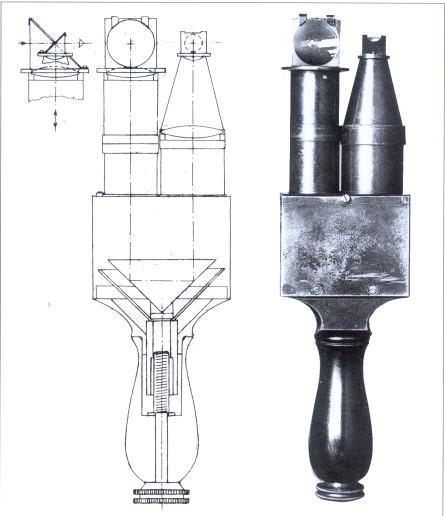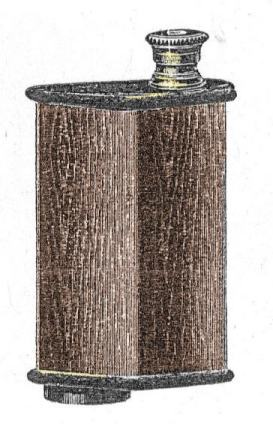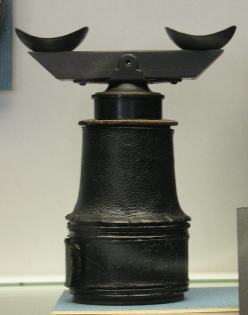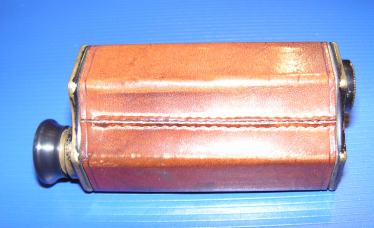
Bild: Franz/Reutinger: "Steinheil - Münchner Optik mit Tradition, 2001, S. 297-298
| Unabhängig davon soll auch von C.A. Steinheil (München) ein Versuchsmodell mit Porro 2 System und angekitteten Linsen, das "Cornet-Lorgnon" entwickelt worden sein. Ein Prototyp befindet sich im Deutschen Museum München. Es hat an einem unteren Haltegriff ein Rändelrad zum Verschieben des 90° Prismas als Fokussierung. | Also C.A. Steinheil (Munic) is said to have developped a prototype with a porro 2 system, and lenses cemented to the prisms: the "Cornet-Lorgnon". There is one prototype in the a "Deutsche Museum" Munic. A knurled wheel at the handle moves the 90° prism inside for focusing. |

Bild: Franz/Reutinger: "Steinheil - Münchner Optik mit Tradition, 2001, S. 297-298
| Hingegen entwickelte Emil Busch (Rathenow) in Kenntnis der Porroschen Patente ein Porro-1-Prismenglas mit 12½x Vergrößerung (Gesichtsfeld: 2,6° - 45m/1000m, Helligkeit: 4,4, Höhe: 15 cm). Das Monokular hatte eine Okularfokussierung, die Porro-Prismen waren auf einem Trägersystem angebracht und in einem dreieckiges Mahagonigehäuse mit Objektivdeckel eingebaut. Der vorhandene Prototyp ging bei Zerstörung des Betriebsgebäudes im 2. Weltkrieg verloren. |
Knowing about Porro's patents, Emil Busch (Rathenow) constructed a porro 1 prism glass with a 12½x magnification (f.o.v.: 2,6° - 45m/1000m, brightness: 4.4, length: 15 cm). The monocular had an ocular focusing, the porro 1 prisms were mounted on a rack, and set into a triangular mahagoni housing with an objective cover plate. |


Bilder adaptiert v. K. Albrecht ‚ Der älteste Busch-Prismenfeldstecher' DOW 1924 612ff.
| Ein etwas anderes geartetes Prismenglas stammt von Lafleur & Roubt (oder Roulot): das "Lunette Prismatique" datiert aus der Zeit um 1865/70. Ein Exemplar ist im Optischen Museum Jena zu sehen. Im Grunde ist es ein Galileisches Glas (Tubus) mit einem Auszugstubus und mit zwei Okularen, die den Strahlengang mit rhomboiden Prismen ausrichten. | A differently designed prism glass was made by Lafleur & Roubt (or Roulot): the "Lunette Prismatique" dating from around 1865/70. One model is on display in the "Optische Museum Jena". Basically it is a Galilean glass with an objective tube and one draw. The ocular end has two eyepieces with rhomboid prisms conducting the path of light to the eyes. |


Abb: Beez/Seeger "Fernglasraritäten..." (DOZ 11/93,S. 26); Foto: Zeun
Porro 1 Glas eines umbekannten HerstellersEin 10x15 Porro-1-Prismenglas mit einer konkaven und rechtwinkligen Grundform (100x30mm, 198g) und Drehokular könnte ein weiterer Prototyp sein. Die Art des verbauten Prismenglases (geringe Lichtdurchlässigkeit), die handwerkliche Ausführung und Belederung lässt auf eine Herstellung vor 1890 und darüberhinaus auf einen versierten Mechaniker und Optiker schliessen. |
Porro 1 Glass by an unknown makerFinally, a 10x15 porro 1 prism glass with a concave and rectangular base (length: 100x30mm, 198g) as well as aturnable ocular might be another prototype. The kind of prism glass used (low light transmission), the applied handicraft and leather covering hints at time of making before 1890, and some versatile mechanic and optician. |



Fotos: 1-2 Zeun; 3 G.v.Ginkel (Sammlung Ginkel)
Fotos: Zeun